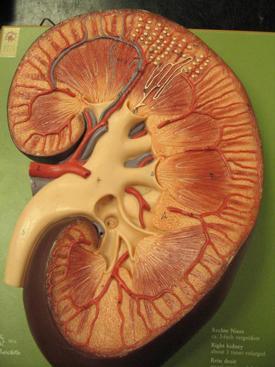
Image adapted from Green Flames 09 under a Creative Commons license: BY.
This sequence addresses the various structural components in the kidney are specialized for processing of the filtrate and production of urine. It also covers homeostatic mechanisms involved in the control and regulation of fluid, electrolyte and acid-base balance, as well as metabolic processes in eliminating nitrogenous waste such as urea and uric acid.
Sequence Director:
Tamara Stein, Ph.D.
dScribes:
Dannie Chang
Tao Zhu
Syllabus
Introduction and Broad Objectives
The objective of this sequence is to obtain, synthesize, and use integrated information regarding the normal structure and function of the renal system. By the end of the sequence, students will have acquired a working knowledge of:
- the structural components of the kidney and how each is specialized for its function of processing filtrate and producing urine,
- the homeostatic mechanisms involved in the control and regulation of fluid, electrolyte, and acid-base balance, and
- how nitrogenous waste is eliminated.
Studying normal structure and function will provide a basis for understanding pathologic changes and physiologic consequences of these changes. To this end, clinical problems related to various pathophysiologic conditions in the renal system are discussed in this sequence. The sequence also includes a multidisciplinary conference and a small group session addressing the clinical consequences of water/electrolyte balance and acid/base problems. More specific objectives and expected learning outcomes for each lecture and lab will be provided in each session, or may be found in lecture handouts or in the sequence syllabus.
In addition to the topics directly related to the renal structures and functions, gross dissections of the abdominal region will be initiated. The anatomy of the abdominal wall and inguinal region will be dissected in this sequence, in preparation for the dissection of the digestive organs in the following sequence. In order to preserve the spatial relationship of the various abdominal organs, especially the digestive organs, actual dissections of the kidneys and other urinary organs will be delayed until the GI sequence. Instead, the anatomy of the kidneys will be studied using plastinated organs in this sequence.
Small Group Discussions
This session will provide students with an opportunity to discuss, analyze, and interpret signs and symptoms as they relate to the underlying physiological principles learned. The purpose of this session is not to teach you how to diagnose specific diseases, but to provide practice in applying physiological principles to interpreting various pathophysiologic states. The problem to be discussed, and questions you will be expected to consider during the discussion, will be provided prior to the discussion.
Attendance Policy
In the Renal sequence there are two required experiences (in addition to FCE and LC events). If a student cannot attend, he/she must contact the class counselor in advance (or as soon as possible in an emergency) to request a deferral. Should you obtain a deferral from your class counselor, make up instructions for the required experiences are:
- Required Patient Presentation on 12/17 - watch the video and write a 2-page response paper describing the patient presentation. This is due by 5 PM on 12/19/08.
- Physiology Small Groups – written answers to the small group discussion questions. This is due by 5 PM on 12/19/08.
Recommended Texts
There are several high quality texts. Students are encouraged to select one of the following:
- Costanzo, Physiology 3rd edition (2006), chapters 1, 6 & 7
- Ganong, Review of Medical Physiology 22nd edition (2005), chapters 38 & 39
- Hall and Guyton, Medical Physiology 11th edition (2005), chapters 1, 25-31
Sequence Examination and Grading
Performance will be assessed by one quiz at the end of the first week and a comprehensive final examination. The final exam will include both online written questions and gross anatomy lab practical questions. The practical exam will take place in the gross laboratories in the afternoon of December 19 (Friday). The online written portion of the final examination will open at 5:00 PM on Thursday (12/18) and will close at 11:59PM on Sunday (12/21). The number of quiz and exam questions will be approximately proportional to the time allocated for lectures and laboratory hours. All exam questions weigh equally and are worth one point. To pass the sequence, students must achieve a minimum score of 75% and fulfill the responsibilities to the Small Group Exercise and Multidisciplinary Conference.
Renal Sequence Lecturers and Faculty Contacts
- Sequence Coordinator: Tamara Stein, Ph.D. Anatomical Sciences
- Physiology: Joan Keiser, Ph.D. Department of Molecular and Integrative Physiology
- Biochemistry: Robert Lyons, Ph.D. Department of Biological Chemistry
- Gross Anatomy: Thomas Gest, Ph.D. Anatomical Sciences
- Histology: J. Matthew Velkey, Ph.D.
Lecture: Michael Hortsch, Ph.D.
Cell and Developmental Biology - MDC: Rachel Perlman, M.D. Internal Medicine - Nephrology
- Clinical Lecture: Richard E. Burney, M.D. Department of Surgery - General Surgery
- Staff Support: Sara J. Weir
Learning Outcomes
The objective of this sequence is to obtain, synthesize, and use integrated information regarding the normal structure and function of the renal system. By the end of the sequence, students will have acquired a working knowledge of:
- The structural components of the kidney and how each is specialized for its function of processing filtrate and producing urine.
- The homeostatic mechanisms involved in the control and regulation of fluid, electrolyte, and acid-base balance.
- How nitrogenous waste is eliminated.
The sequence also includes a multidisciplinary conference and a small group session addressing the clinical consequences of water/electrolyte balance and acid/base problems. More specific objectives and expected learning outcomes for each lecture and lab will be provided in each session, or may be found in lecture handouts or in the sequence syllabus.
Reading List
Recommended Textbooks
There are several high quality texts. Students are encouraged to select one of the following:
- Costanzo, Physiology 3rd edition (2006), chapters 1, 6 & 7
- Ganong, Review of Medical Physiology 22nd edition (2005), chapters 38 & 39
- Hall and Guyton, Medical Physiology 11th edition (2005), chapters 1, 25-31

Image adapted from Green Flames 09 under a Creative Commons license: BY.
| Document Title | Creator | Downloads | License |
|---|---|---|---|
|
12.09.08 Example Questions: Amino Acid lectures |
Robert Lyons
|
||
|
12.09.08 Lecture Handout: Amino Acid Metabolism (Nitrogen Metabolism) |
Robert Lyons
|
||
|
12.11.08 Lecture Handout: Folate Metabolism |
Robert Lyons
|
||
|
12.12.08 Lecture Handout: Nucleotide Metabolism |
Robert Lyons
|
| Document Title | Creator | Downloads | License |
|---|---|---|---|
|
12.08.08: Histology of the Urinary Tract |
Michael Hortsch
|
||
|
12.09.08: Amino Acid Metabolism (Nitrogen Metabolism) |
Robert Lyons
|
||
|
12.11.08: Folate Metabolism |
Robert Lyons
|
||
|
12.12.08: Nucleotide Metabolism |
Robert Lyons
|
| Document Title | Creator | Downloads | License |
|---|---|---|---|
|
2006 Daily Schedule: M1 Renal |
Dept. Staff
|
||
|
2007 Daily Schedule: M1 Renal |
Dept. Staff
|
||
|
2008 Daily Schedule: M1 Renal |
Dept. Staff
|
||
|
2009 Daily Schedule: M1 Renal |
Dept. Staff
|



